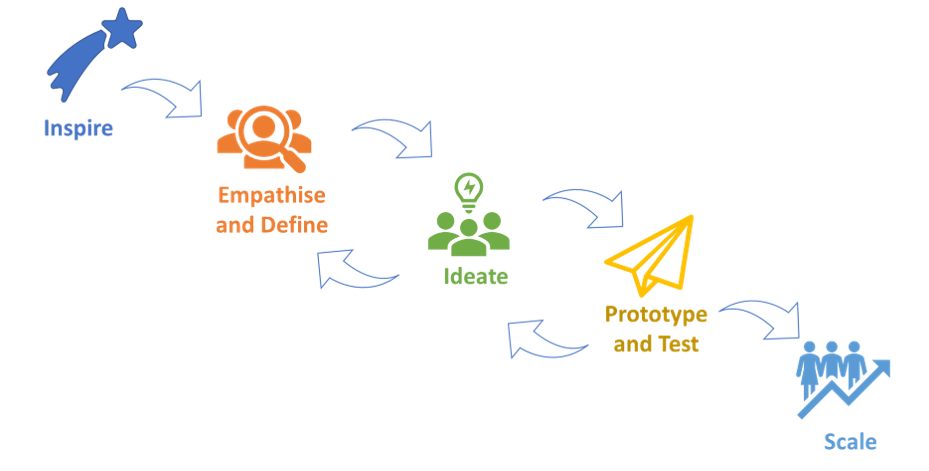Introduction:
Dr Pavan Soni is an Innovation Evangelist and the founder of Inflexion Point, a strategy and innovation consultancy. A teacher by passion he completed his PhD from IIM Bangalore in the domain of Strategic Management. He is also an Adjunct Professor at IIM Bangalore, ISB Hyderabad and IIM Lucknow. To know more, visit: www.inflexionpoint.net
Design Thinking is a human-centred, systematic approach to problem-solving. With its roots in product and industrial design, design thinking is often associated with the world of tangibles. However, the likes of IDEO and Stanford d.school are bringing the technique to the mainstream business, and a growing number of organizations are embracing the tenets and approaches to designing superior human experiences.
The graduation from designing products and services to crafting meaningful experiences is an important one. Yet, if you ask most executives about their understanding of design thinking, the word ‘design’ dominates thinking. The perception is that it’s an approach to designing smart products, often in the hi-tech realm and suitable for startups. This article aims at dispelling this very myth and offering means through which a more comprehensive host of organizations can embrace this meaningful approach to solve their thorny problem elegantly.
The Move from Products to Services to Designing Memorable Experiences
We all crave for authentic experiences. That’s why millions of Indians queue up outside stadiums to see their favourite players in action or spend a fortune to experience their dream vacations. While TED talks are available online for free, and yet being in the company of the thinkers and doers remains priceless, literally. The investment on innovation has shifted from pumping in more technology to expand the possibilities, to hiding the technologies so that benefits could be highlighted. Minimalism has become the dominant way of thinking and designing, and products and services have given way to compelling experiences.
These experiences aren’t necessarily between the organization and its customers; but also, between other individuals, regardless of their function or position in the value chain. With experiences growingly occupying centrality the amount of intangibility has gone up, and this means you have to design things that you can’t see, you can’t inventory, and even predict with a high level of certainty. And yet they must be designed and delivered with consistency, by people and using technology that is not always in your control. This calls for a systems-level of thinking, and empathy of the highest order. You can think of how Disney almost engineers visitor experiences across its theme parks in a very reliable manner, or how Pixar manages to espouse the right emotion from the child within you every time you engage with one of its creations. Regardless of the industry you are a part of, designing memorable experiences is everyone’s job, and with design thinking, this can be done more predictably and reliably.
Treat Design Thinking as an Addition, and Not a Replacement
One of the most relevant and frequent questions I’ve come across is— “does design thinking render all the previous models of problem-solving irrelevant?” The answer is undoubtedly no. Then what is the distinctive contribution of design thinking?
There do exist some powerful methods of problem-solving, ranging from TRIZ (Theory of Inventive Problem Solving) to Lateral Thinking, Blue Ocean Strategy framework, SCAMPER, and Theory of Constraints (TOC) – each with its distinctive strength and applicability. For instance, the Russian technique of TRIZ is most amicable for addressing physical constraints, whereas TOC suit scenarios involving process issues and flow-related problems. Then there are a host of tools from the realms of Lean Thinking, Six Sigma, and Agile, among others, that come in handy while solving point problems or aiming at continuous improvement. The view that design thinking attempts to bring to practice is human-centricity with a focus on empathy. Making who (read the customer) more central to the discussion than what (read the problem), design thinking helps uncover one of the most severe blind spots in any problem-solving exercise – a loss of context. To add to this, the prominence of an iterative model of idea generation and validation, coupled with visualization and collaboration techniques add to taking a more holistic view, which further helps tie the loose ends. So, you don’t have to replace your existing and well-working models of problem-solving (provided you have one). Instead, it would be best if you borrowed inspiration and disciplines from design thinking. To begin with, embrace the significance and some of the practices of empathizing.

The Customer is the One Whose Problem You Wish to Solve
Another critical question is – who’s the customer? While design thinking brings to fore the importance of human centricity, in the world of business, it is narrowly perceived as ‘customer-centricity’. But that needn’t always be the case.
A more precise understanding of the customer is always helpful. Think of a customer as anybody whose problem you wish to solve. It could be your employee, your supplier, an investor, supervisor or subordinate, or perhaps the end consumer. The key is to look at the problem and the person whose problem you want to address. So, if you are in the HR team and far removed from the end-customer, your customers are the employees. Similarly, for a procurement executive, the customer is the supplier and ditto for the person in the finance team for whom the customer is the business that seeks timely approval, help in cost control, and advise on managing expenses.
A broader view of who the customer is would help you embrace customer-centricity more holistically. Companies like Starbucks treats its employees (called associates) as the primary customers, who, in turn, manage the consumer experiences across thousands of the touch-points. Similarly, McKinsey has a clear pecking order – client, firm, and you—which gives the highest priority to the client, followed by the company itself, and only then to the associate. For Google, the developers are important, and for Wikipedia, these are the contributors. Clarity on who the customer is would help exhibit customer-centricity and then help prioritize your ideas as you address tricky problems involving multiple stakeholders.
In summary, as we move towards the world defined by experiences, both personal and professional, it’s time that we pay attention to how they are designed and delivered. Design thinking can offer a disciplined approach, suitable for internal and external customers alike and in conjunction with existing models of problem-solving.
This article was first published in The SatSure Newsletter





Add comment